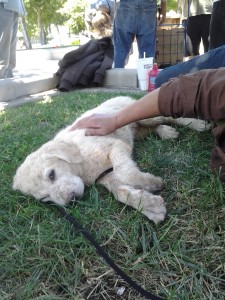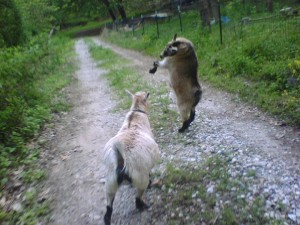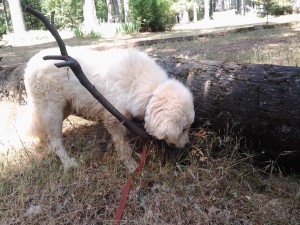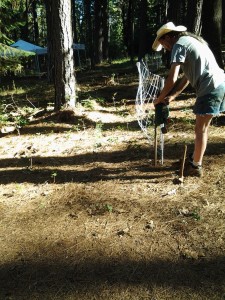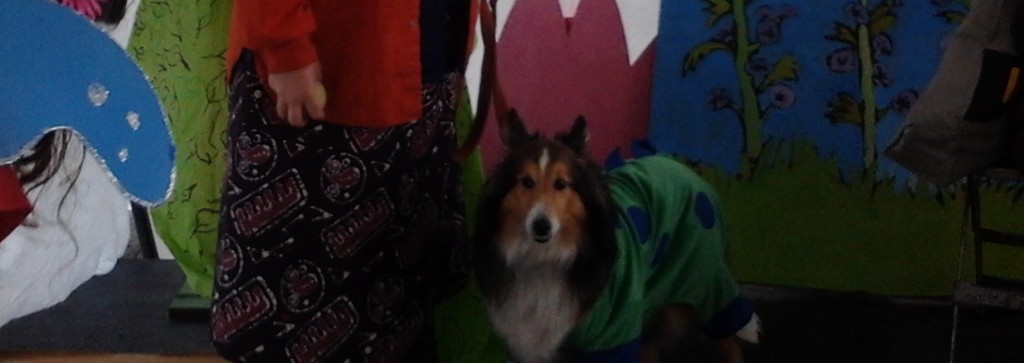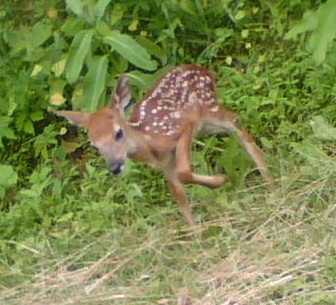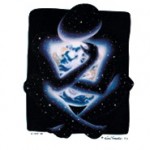Humans Are Exhausting
Dana, our Akbash Livestock Guard Dog pup, is getting used to people. When she came to us a week ago, she had mostly bonded to the goats and dogs in her herd of birth. She came with two of those goats and she quickly made friends with our bottle baby goat and our eight month old LGD. But she just begrudgingly tolerated us human types.
Other than a quick visit with the landlord’s grandchildren, her first exposure to people other than her handlers was last Saturday’s Food Not Bombs public feeding at Chico, California’s City Plaza. Suddenly she was surrounded by cars, adults, children, lapdogs, and the Chico summer heat.
Our Sheltie Tuatha came along as he does most Saturdays. He seemed to enjoy initiating Dana to the public fountain, a great way for furry folks to cool off. Dana got plenty wet, but she mostly just watched the human children jump through the spray while Tuatha barked at the water.
After a few interactions with humans, Dana being passive, as if leaving her body, she finally started to approach people proactively and she seemed to enjoy their touch and talking. By the end of the event, a very tired, wet puppy laid next to our friend Lisa, who gave her more touch.
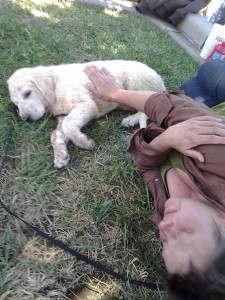
Dana, wet from playing in the fountain, snuggles with her new human friend, Lisa, as the Food Not Bombs feeding winds down.
A few days later, Dana went with me to the feed store and One Mile at Chico’s Bidwell Park, where hundreds of people were cooling off in a pool. Dana was fine, trotting along with me on her leash, no longer doing that puppy death pull. She was curious about people lying down sunbathing, but not enough to trot right up and introduce her cute self. But when one woman with a large family fell in love with her, Dana got lots of attention.
After these trips out into the human world, Dana sees me and runs to me, behavior she wasn’t doing before. Just today, she sought me out and let me rub her belly for several minutes. She does play posture with me and generally has accepted me as part of the herd. Instead of pretending that my partner C.T. is invisible, she’s interested and affectionate.
How will she be with strangers as she matures? As an LGD, she has the genetic programming and early socialization to be wary of strangers until her humans show that they’re acceptable. If her deformed paw or other circumstances determine that she will be a general farm dog or even a pet, we want her to have good human socialization.
Subscribe to this blog's RSS feed
Building the Herd: A Study in How Complicated Simplicity Can Be
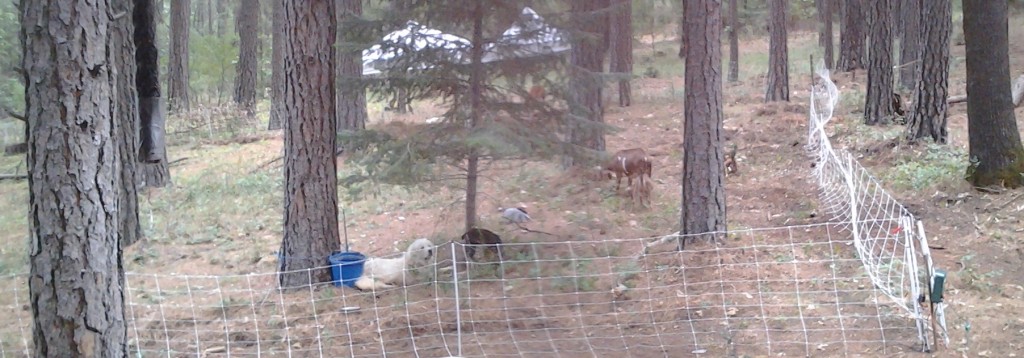 When I started this website and subtitled it “Wren Tuatha’s Complicated Adventures in Simple Living,” I wanted to emphasize the point that simplicity as a value doesn’t mean doing what’s easiest, or even simplest (most expedient) in the moment. Rather, it’s about keeping one’s impacts simplified. That can get very complicated!
When I started this website and subtitled it “Wren Tuatha’s Complicated Adventures in Simple Living,” I wanted to emphasize the point that simplicity as a value doesn’t mean doing what’s easiest, or even simplest (most expedient) in the moment. Rather, it’s about keeping one’s impacts simplified. That can get very complicated!
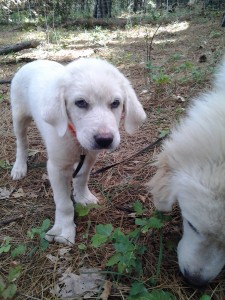 I was just rereading The Art of Raising a Puppy, by the Monks of New Skete. They describe the dynamic in which a dog owner who has lost a mature, elderly dog gets an energetic, untrained puppy. They then judge that pup through the biased filter of their old dog’s obedience and socialization. I could easily have that bias as I build a new herd, remembering how my old goats back in Maryland were so free and easy to be with. We had flow. I forget all the years it took to build up to that state of being. I forget the conflicts with my community mates and fetching the goats out of the garden. I forget work sessions to install fencing and to build a cob goathouse.
I was just rereading The Art of Raising a Puppy, by the Monks of New Skete. They describe the dynamic in which a dog owner who has lost a mature, elderly dog gets an energetic, untrained puppy. They then judge that pup through the biased filter of their old dog’s obedience and socialization. I could easily have that bias as I build a new herd, remembering how my old goats back in Maryland were so free and easy to be with. We had flow. I forget all the years it took to build up to that state of being. I forget the conflicts with my community mates and fetching the goats out of the garden. I forget work sessions to install fencing and to build a cob goathouse.
I just remember the easy routine the goats created. Wicca and Niabi were up at sunrise, following their daily path to their preferred morning browsing grounds. When I got up they would make their way back to my cabin to talk to me through the windows. After a long day of circling the woods to find the best browsing in relation to the sun and my comings and goings, they would settle in under the house, preferring to sleep there, close to me, completely forgoing the beautiful cob house we built them in their secure pen.
For the last few years that I had goats in Maryland, their gate was almost always open and their pen was just another part of the woods to be eaten. They had evolved that level of freedom with me through trust, bonding, and experimentation.
But Maryland has surprisingly few mountain lions. The equation of having woodland goats in California is very different. And this herd will be different, in mission and relationship to me.
Before, I had pygmy goats as pets. I committed to them the way I would a dog or cat—for life. That included health care, the highest quality food and entertainment I could afford, and lots of loving. I don’t know what the future has in store for me and these animals. I’m sharing them with my landlords. Many things are different.
Simplicity Concept: Let’s get pet goats to clear brush instead of using chemicals or human hours!
Complication 1: Seriously Apex Predators
Lions, coyotes, and bears! Oh my! In this part of the country, if you have a herd or flock of any kind, even chickens, you either have Livestock Guard Dogs or you have losses. We will spend more on dogs than fencing. Since we are only going to have four goats, I have insisted we only need one dog, Tonka.
He’s an eight month-old Akbash/Anatolian/Great Pyrenees mix. But another herd owner wore me down and talked me into adopting Dana, a ten week-old Akbash pup with a deformed paw. Mandy, who has seventy goats, wanted me to have the pup as, the dogs work best in teams. Although my reading suggests LGD’s take two years to mature into the job, Tonka’s doing an amazing job already. He chased a pair of coyotes off just yesterday. He also alerted us when the bottle baby got stuck in a hole. Dogs are a great addition!
Complication 2: Please Fence Me In!
With mountain lions about, evolving goats into being free range is not realistic. Since we want them to clear brush all around the landlord’s forty acres, we’ll need movable fencing. Technology has marched along and the trend now is
electric netting. The shock is quicker and milder than old style fences and the sections are lightweight and easy to move and install. The power can be household current, battery or solar. In the old days I would have thought this inhumane. I remember the jolts the electric fences on our farm would deliver. But each herd member only has to contact the netting a couple of times and they respect the fence forever. The netting also provides some deterrent to predators.
Complication 3: LGD’s Don’t Know Sit
Livestock Guard Dogs are bread to know their job innately and learn what they don’t know from elders on the job. They’re born with the herd and they bond with goats and other dogs, not so much with humans. Their human handler needs to take alpha rank over the dogs but, like many show dogs, basic obedience is not needed or taught. So when we brought Tonka home, he was used to a leash but didn’t heal, sit, stay or down. Sorry, but if I’m going to handle a herd that includes a dog that could approach a hundred-fifty or two hundred pounds, I need him to sit on command.
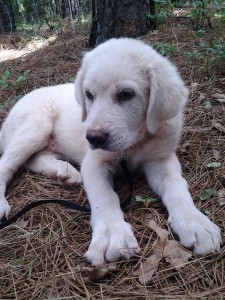
Dana drags a leash to aclimate to it. She'll get surgery soon to improve her deformed right front paw.
Although Tonka is unusual in that he’s submissive and people friendly, the pup Dana wants little to do with humans. According to the Monks of New Skete, I’ve got just three weeks or so to socialize her to a variety of humans, otherwise she will have a very hard life if her deformed paw limits her LGD career. So now I’m a dog trainer.
Complication 4: Some Goats Are Gruff
I previously kept pygmy goats, a dwarf breed. My heaviest goat was maybe seventy pounds. I usually got them upon weaning and was very hand-on. Others I got from pet herds. That’s common with pygmies, which are kept more by fanciers than farmers. So I was used to very tame goats. When I got Ponder, the bottle baby, I knew she would grow to one hundred-thirty pounds. But I’m her mama. She’s tame. But the adult wether and young doeling Mandy gave us came from a herd of seventy brush goats. They’re used to seeing humans, but human touch equals unpleasantness—shots, transportation, and this time, rehoming. 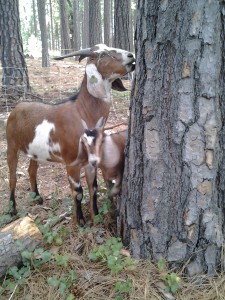 So I have a goat twice the size that I’m used to, he has a huge rack of horns, and he’s not interested in being my friend. Never underestimate the power of feed pellets. You will be mine, Guru!
So I have a goat twice the size that I’m used to, he has a huge rack of horns, and he’s not interested in being my friend. Never underestimate the power of feed pellets. You will be mine, Guru!
Complication 5: Surprise! This Stuff Costs Money!
I’m perfectly clear that I’m starting this herd for enjoyment of their company as well as brush clearing. Otherwise, if brush clearing were the sole benefit, I’m not sure the finances, effort, and time would make good math. Then again, I’ve met several folks who run brush herds for money, so they must make it work on a certain scale. Luckily the landlord and I each have a few collars, halters, leashes, bowls, toys, etc., left over from previous animals. We’re trying to make due with odds and ends we find in these tough economic times. We won’t eat or milk these goats, nor get any fiber from them. So brush clearing and entertainment are our only benefits. But goats and dogs need shots and sometimes have accidents, creating emergency vet bills. Add in puppy food for two and supplemental grains and hay for the goats. Thanks to another goat person, Jen, we’re getting goat milk for the bottle baby. That’s a generous gift, and great savings. The horse barn was already here and the landlord used recycled materials to adapt it to goats. I am repurposing my two EZUp canopies to create shelter in the movable pen.
Simplicity Is Responsibility, not Ease
Live simply so others can simply live. I notice people often falling into a couple of traps in their understanding of Simplicity. One is thinking that it’s about benefits to the individual. I’ve seen it packaged that way, and certainly Americans understand things in individualist terms. People want simplicity to mean more time with their kids, more time for hobbies, less time working an unsatisfying job, fewer possessions by which to be owned. It can be all these things, but this is the shallow end of the pool, and it doesn’t account for simplicity’s complications, as I sketched out above. But going deeper, simplicity is about taking no more than your share of resources, so others can access their shares. Live simply so others can simply live. Modulate your privilege.
The other trap I’m thinking of is the idea that money is the root of all evil and that simplicity must mean a life without money, to the greatest extent possible. I’m not sure, but I’m told that the actual quote is, “the love of money is the root of all evil.” That certainly changes things for me. I see money, like time, labor, etc., as a form of energy. Any energy can be expended for good or bad by anyone. I’ve often said that money can’t buy you love, but it buys you choices. And in a thoughtful simplicity practice, you can choose to spend money to ethically benefit people in your local region and around the world who are trying to simply live.
Simplicity isn’t about you.
—WT
Curl Murder: “How Could You Do That to Your Hair?”


 My mother’s desire to be an accepting individual doesn’t mean she’s going to hold her tongue when she has an opinion. In fact, I guess we’re a lot alike that way.
My mother’s desire to be an accepting individual doesn’t mean she’s going to hold her tongue when she has an opinion. In fact, I guess we’re a lot alike that way.
 Even so, I found it ironic that, in the fifteen or more years that I’ve been carrying dreadlocks, she’s often commented on the many nonlocked ways she likes my hair, and how those more socially acceptable ways show off my abundant curls. I find this ironic because she spent my entire childhood trying to comb out said curls, cut them into a bob, or at least train them into little wetted spirals held overnight with bobbie pins, making different curls than the ones that naturally sprout from my scalp.
Even so, I found it ironic that, in the fifteen or more years that I’ve been carrying dreadlocks, she’s often commented on the many nonlocked ways she likes my hair, and how those more socially acceptable ways show off my abundant curls. I find this ironic because she spent my entire childhood trying to comb out said curls, cut them into a bob, or at least train them into little wetted spirals held overnight with bobbie pins, making different curls than the ones that naturally sprout from my scalp.
 I got off easy in the girl-child-of-the-seventies-hair-torture department. My older sister had to sleep in juice can curlers. They weren’t just the size of juice cans, they were actual juice cans with her long, straight hair wrapped around them. My younger sister, also cursed with straight hair, but tender-headed, was subjected to the curling iron.
I got off easy in the girl-child-of-the-seventies-hair-torture department. My older sister had to sleep in juice can curlers. They weren’t just the size of juice cans, they were actual juice cans with her long, straight hair wrapped around them. My younger sister, also cursed with straight hair, but tender-headed, was subjected to the curling iron.
My straight-haired mom went for perms every three months. The perm process took hours. The chemical smell  burned our eyes and left actual burns on the scalp as it burned her hair into whatever curl she wanted. Sometimes she’d dye the gray away, or go for streaks or highlights.
burned our eyes and left actual burns on the scalp as it burned her hair into whatever curl she wanted. Sometimes she’d dye the gray away, or go for streaks or highlights.
Given what mainstream folks do to their hair regularly, I’m perplexed at the occasional weird reaction to a gentle hair practice that involves no chemicals and is rooted in community, familial interaction and connection to nature. But I realize we’re all coming from culture and what’s familiar.
 The other undercurrent of comments from my White friends and family is some good old fashioned curl coveting. If I’m not going to use them, someone else should have them, right?
The other undercurrent of comments from my White friends and family is some good old fashioned curl coveting. If I’m not going to use them, someone else should have them, right?
I’m pensive about the zenophobia that seems to frame the rare brave comment. I was in an elevator in a library in Lexington, Kentucky. A woman asked me about my locks. “They’re different,” She concluded. “To you,” I answered. She thought for a moment. “No, they’re different,” she  repeated. Her world was the entire world.
repeated. Her world was the entire world.
Although such comments are rare, some folks at the York Fair in Pennsylvania really laid it on thick. “You don’t belong here. What country are you from?” My home of nearly twenty years was just twenty minutes from where I was standing, in the country where I’ve lived every day of my life, except for that summer in Spain when I was fifteen and that day my family drove into Canada while visiting Michigan.
 As a matter of fact, a few miles from the York Fair at Spoutwood Farm, I used to attend the annual Faerie Festival. That crowd, sometimes reaching ten thousand in a weekend, was the place where I was least different, surrounded by a high percentage of dreadlocked hippie folk.
As a matter of fact, a few miles from the York Fair at Spoutwood Farm, I used to attend the annual Faerie Festival. That crowd, sometimes reaching ten thousand in a weekend, was the place where I was least different, surrounded by a high percentage of dreadlocked hippie folk.
After the first few years of carrying locks, I was long past concerning myself with the store security guard who followed me around or the eyes that might do  double takes when I entered a room. I was busy living my life. If people did have stereotypes, as soon as I would speak, it was clear that I was not stoned and that I had come to conduct serious business. I was never aware of my hair closing any doors that I wanted to enter.
double takes when I entered a room. I was busy living my life. If people did have stereotypes, as soon as I would speak, it was clear that I was not stoned and that I had come to conduct serious business. I was never aware of my hair closing any doors that I wanted to enter.
But when I began spending time with my partner, C.T., he had an interesting vantage point, walking into a restaurant after me, or watching me in a parking lot. He would see every double take that I was missing because I  was just being myself, and didn’t care. He made a game out of projecting what each onlooker was thinking. It reminded me that with every point of contact, I was adjusting each person’s normal/different continuum.
was just being myself, and didn’t care. He made a game out of projecting what each onlooker was thinking. It reminded me that with every point of contact, I was adjusting each person’s normal/different continuum.
I like the tradition of working (maintaining) locks as a familial or communal practice. When I started my first set, I threw a party and asked my Heathcote Community mates to start them. I got some feedback that this felt odd or self absorbed. So I established the next set  myself. I did teach C.T. to maintain my locks and when they grew so long and heavy that I was having neck pain, he ritually cut them for me, symbolizing also, the end of our time with Occupy Wall Street. Now he’s helping me start a new set.
myself. I did teach C.T. to maintain my locks and when they grew so long and heavy that I was having neck pain, he ritually cut them for me, symbolizing also, the end of our time with Occupy Wall Street. Now he’s helping me start a new set.
This is the set of locks I’ll carry as I go gray, as C.T. and I go deeper in our relationship and our teaching of consensus. What new places and people will add their energy to these locks? Our dog will grow old and die. Will we  make it to California? Where will we put down roots and establish our consensus institute?
make it to California? Where will we put down roots and establish our consensus institute?
In this time of new beginnings, it is time to begin new dreadlocks.
—WT
How I Know There Are Sixty Drawers in My House
 Drawers really add up. You look at a dresser and it has four drawers. You don’t think to do a room to room survey to find out how dressers and filing cabinets and desks and sideboards collaborate with the kitchen to really run up your drawer tally. You don’t go room to room, because, why would you?
Drawers really add up. You look at a dresser and it has four drawers. You don’t think to do a room to room survey to find out how dressers and filing cabinets and desks and sideboards collaborate with the kitchen to really run up your drawer tally. You don’t go room to room, because, why would you?
Neither did I.
Then came today, when my partner and I had been out running errands with our dog, who loves being “on the away team.” When we got to our door and it opened without a key, we could plainly see we’d been burglarized.
 The predominant visual was that every drawer was pulled out, some tossed on the floor, contents scattered.
The predominant visual was that every drawer was pulled out, some tossed on the floor, contents scattered.
Yes, we called 911 and followed instructions to leave the house and sit in our locked car until the police came. Three officers in three separate patrol cars arrived and blocked off our cul-de-sac. They circled the outside, then surveyed inside, guns drawn. They gave us the all clear and had us survey for missing items. We tried and tried, but we couldn’t come up with a single item that was missing.
Our possessions were so lame the police didn’t even give the complimentary lecture on how to make our home more secure. If I made enough to pay taxes, I might feel ripped off. I thought they always gave the lecture.
Now that I’ve given you the down and dirty on the deed, back to the interesting stuff about drawers. Room by room, I followed in the footsteps of my burglar, imagining what he or she thought while pulling out every single drawer in our file room.
 Yes, in the drawer tally I have an unfair advantage because we have a file room. I have drawers and drawers of my writings, and C.T. has saved statistics and other information on every Food Not Bombs feeding, activist event, theatrical production, and consensus workshop he held—I mean feeding head counts, menus, promotional fliers, etc., and date books going back to 1983. We’ve been moving his archives from house to house, planning to write his memoirs.
Yes, in the drawer tally I have an unfair advantage because we have a file room. I have drawers and drawers of my writings, and C.T. has saved statistics and other information on every Food Not Bombs feeding, activist event, theatrical production, and consensus workshop he held—I mean feeding head counts, menus, promotional fliers, etc., and date books going back to 1983. We’ve been moving his archives from house to house, planning to write his memoirs.
What did our burglar think, opening a file drawer to find dog costumes, or pulling out my middle desk drawer to find little gemstone dinosaurs? Well, I like to think that I’m unique, interesting, even thought provoking. But this burglar was probably not moved. Nothing in these actions was about me.
Our neighbors were a flurry with updates and advice in the hours after our break in. It turns out a house in the opposite cul 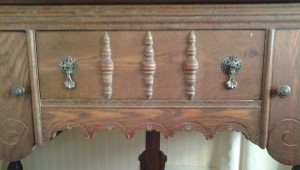 de sac was also broken into around the same time, and again, nothing taken. People theorized what the burglars might have been looking for—cash, illegal drugs, prescription drugs (oxy-anything), small electronics. Was it a gang initiation or training exercise?
de sac was also broken into around the same time, and again, nothing taken. People theorized what the burglars might have been looking for—cash, illegal drugs, prescription drugs (oxy-anything), small electronics. Was it a gang initiation or training exercise?
We will almost certainly never know. And as our friend Ross, who owns the house, was here fixing the broken front door, I marveled that I really was not very upset. Acknowledging that events could have gone very badly, up to and including death, this was a mild event, a warning to be careful.
 What struck me? Apart from reflecting that the event could have gone down in many different ways and those I care about might have been hurt (read: dog), I have fixated on the realization that, without the task of going from room to room closing drawers, I might never have noticed that there are sixty drawers in this house. What does it mean? It feels like just a poetic little factoid, maybe a message to scale down my possessions further, maybe a cute, meaningless parallel in the year that C.T. is turning sixty years old. Maybe I am just pondering myself, hurling through 2013 in this little house on spaceship Earth, clinging to all the drawerspace I can maintain.
What struck me? Apart from reflecting that the event could have gone down in many different ways and those I care about might have been hurt (read: dog), I have fixated on the realization that, without the task of going from room to room closing drawers, I might never have noticed that there are sixty drawers in this house. What does it mean? It feels like just a poetic little factoid, maybe a message to scale down my possessions further, maybe a cute, meaningless parallel in the year that C.T. is turning sixty years old. Maybe I am just pondering myself, hurling through 2013 in this little house on spaceship Earth, clinging to all the drawerspace I can maintain.
What am I storing? Clearly nothing a burglar wants.
C.T.’s DIY Book Process
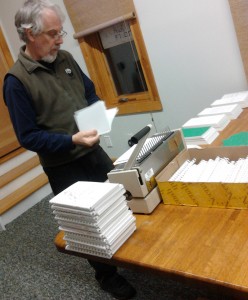 Many people wonder about the plastic binding of C.T.’s original book, On Conflict and Consensus. Originally a cost saving measure, C.T. has continued to order new printings with that spine because so many people have liked that feature, which allows them to easily lay the book open at meetings for quick reference.
Many people wonder about the plastic binding of C.T.’s original book, On Conflict and Consensus. Originally a cost saving measure, C.T. has continued to order new printings with that spine because so many people have liked that feature, which allows them to easily lay the book open at meetings for quick reference.
What they probably don’t ever consider is that C.T., Mr. Do-it-yourself, binds each copy himself, using a binder he has lovingly maintained and repaired since the 1980’s!
The printer sends C.T. boxes with the book divided into sections, into which C.T. cuts holes with the machine. Then the machine stretches the plastic spine and the ordered sections are laid inside.
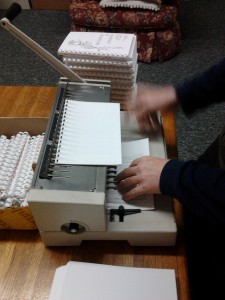 Each book takes a few minutes. And C.T. binds the copies in batches of two-hundred or so. Since its first publication in 1987, C.T. has sold well over ten-thousand copies, each of which he bound himself, spreading culture change by his own hands.
Each book takes a few minutes. And C.T. binds the copies in batches of two-hundred or so. Since its first publication in 1987, C.T. has sold well over ten-thousand copies, each of which he bound himself, spreading culture change by his own hands.
Through the years, he’s sometimes accepted help and shown others how to bind the books. But they usually didn’t bring the same mindfulness to the practice, and would often mess up the cutting or get the sections in the wrong order, ruining several copies. That made for a very costly learning curve, so C.T. prefers to carry on the practice himself.
On Conflict and Consensus and Consensus for Cities are made possible by investors who cover the cost of printing, and some of our costs of distributing the book. So when a book is ruined, we still need to pay back investors for that loss. The investors are one reason why we can’t give the books away, as we’re often asked to do.
His other books, Food Not Bombs: How to Feed the Hungry and Build Community and Consensus for Cities, are perfect bound. And when we go to place his titles on bookstore shelves, the proprietors complain about those plastic spines. They’re afraid they’ll break, rendering the stock unsellable. But we travel around, moving books from place to place, lugging them to events, and we have no problem.
 While we’re on the road, we’ve had to guess at how many books to bring. And C.T. brought the binding machine with us. These photos were taken at our friends’ house in Manorville, on Long Island, where we stayed for several weeks. Over several days, C.T. bound a couple hundred books while I organized our Consensus: Body and Soul workshop at WBAI. We had already hosted several Occupy activists from OWS, Philadelphia and Boston for a workshop in that very room.
While we’re on the road, we’ve had to guess at how many books to bring. And C.T. brought the binding machine with us. These photos were taken at our friends’ house in Manorville, on Long Island, where we stayed for several weeks. Over several days, C.T. bound a couple hundred books while I organized our Consensus: Body and Soul workshop at WBAI. We had already hosted several Occupy activists from OWS, Philadelphia and Boston for a workshop in that very room.
Tuatha, of course, would spend his time enjoying every dog’s dream chair, waiting for us to stop working and kick the ball around!
—WT
Dragons Are Not Afraid of Thunder, or A Fine Time at the St. George Day Festival
How do I end up in a pet dragon contest when I’m supposed to be coteaching a consensus workshop in Philadelphia? My life is like a road movie, just a string of random randomness.
Having postponed a workshop in Philadelphia, C.T. and I found ourselves with time to volunteer for and attend the St. George Day Festival here on Staten Island, our new home for a while. The event is organized by our friends at Every Thing Goes Book Cafe and Neighborhood Stage. The cafe is one of several businesses run by Ganas Community. We had been looking for time to plug in. So, with our schedule cleared and despite predictions of rain, plug we did.
 After our own battles with a printer dragon that wouldn’t give us the brochures we wanted, we hiked over to Ganas to help transport food. Once at the festival site, we were assigned the art project of reinforcing the bent fire and scales on a cardboard
After our own battles with a printer dragon that wouldn’t give us the brochures we wanted, we hiked over to Ganas to help transport food. Once at the festival site, we were assigned the art project of reinforcing the bent fire and scales on a cardboard  dragon for the parade. I can’t say that we improved it much, but the dragon did march and we enjoyed seeing our small work in the show.
dragon for the parade. I can’t say that we improved it much, but the dragon did march and we enjoyed seeing our small work in the show.
We helped staff the local authors table. It was interesting to see the range of books and listen to the authors read. Our own books were a little out of place there. But soon we got an invitation from the Green Bus folks, who knew of C.T.’s work with Food Not Bombs. So our materials moved. C.T. had a great time swapping stories with activists from Occupy Wall Street, Occupy Staten Island, Food Not Bombs and more.
Around that time, we found out that there was to be a pet dragon contest. As it turns out, we have a pet dragon, at least part time, specifically when it thunders.
Our sheltie Tuatha is powerful afraid of storms. And fireworks…and any other stimulation that dogs of the ages have ever tried to fear. I saw the ads for the so called “thundershirts,” and I was intrigued but skeptical, especially because the marketing included lots of fake blogs pretending to be independent testimonials.
The ads/blogs implied that the science behind the thundershirt is that it presses on certain acupuncture points on the dog, calming and making her/him feel more secure. Well, that sounds reasonable, but I couldn’t quite justify the expense without knowing it would work on my particular paranoid pup.
That’s when I remembered that Tuatha has a huge collection of Halloween costumes. I knew right away that our favorite, the dragon, would fit snugly in the way that the thundershirts in the pictures do. I tried it the very next time it stormed.
It worked. I would like to tell you a story of false advertising and how they’re just stealing your money. Well, if you have a drawer full of doggie Halloween costumes, it might be the case that you don’t need to give the thundershirt people your money. Don’t ask me how it works. C.T. and I have this whole theory about “contingent behavior” that I won’t go into here.
But the short story is that C.T. went home and got our pet dragon in time for the contest. Because the start time was delayed repeatedly, Tuatha the dragon and I walked all around the festival. He was very popular. We got to meet another contestant, Shakespeare, and his humans who were waiting in the wings. I learned more pointers than I will ever be able to blog about how to win dog contests and where to find them. It turns out the competition was professional!
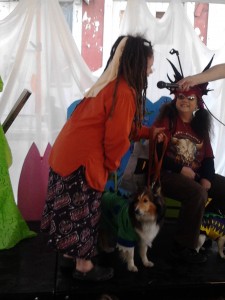 Well, this was only our second contest, the first being a parade in New Freedom, Pennsylvania. We found out about that one the day of. And now the pro’s had a leg up on us again! Shakespeare’s humans velcroed him into a much more elaborate dragon costume, one that didn’t look like he’d worn it for years of trick or treating, hours of playground wrestling and many episodes of thunder.
Well, this was only our second contest, the first being a parade in New Freedom, Pennsylvania. We found out about that one the day of. And now the pro’s had a leg up on us again! Shakespeare’s humans velcroed him into a much more elaborate dragon costume, one that didn’t look like he’d worn it for years of trick or treating, hours of playground wrestling and many episodes of thunder.
But, luck was on our side. It turned out that Shakespeare and Tuatha were the only entrants. And after applause voting (which I’m pretty sure went in Tuatha’s favor) the emcee declared a tie for first place! Fair enough. We got to win!
In other news of the day, we only sold one book but we met many interesting neighbors who would like to learn consensus. And we reconnected with old friends of Ganas Community. We took in interesting poetry and loads of fine local music. And the organizers fed the volunteers a wonderful spread, so we economized there. Very helpful in our line of work.
And we returned to our host’s home with bragging rights—We won the pet dragon contest. What? No state and nationals to follow? That suits Tuatha fine. He loves the idea of going with us when we leave home, but he’s not always thrilled at the places we go. Costumed crowds are no fetish of his.
—WT
Discovering the Secret World of Strollers
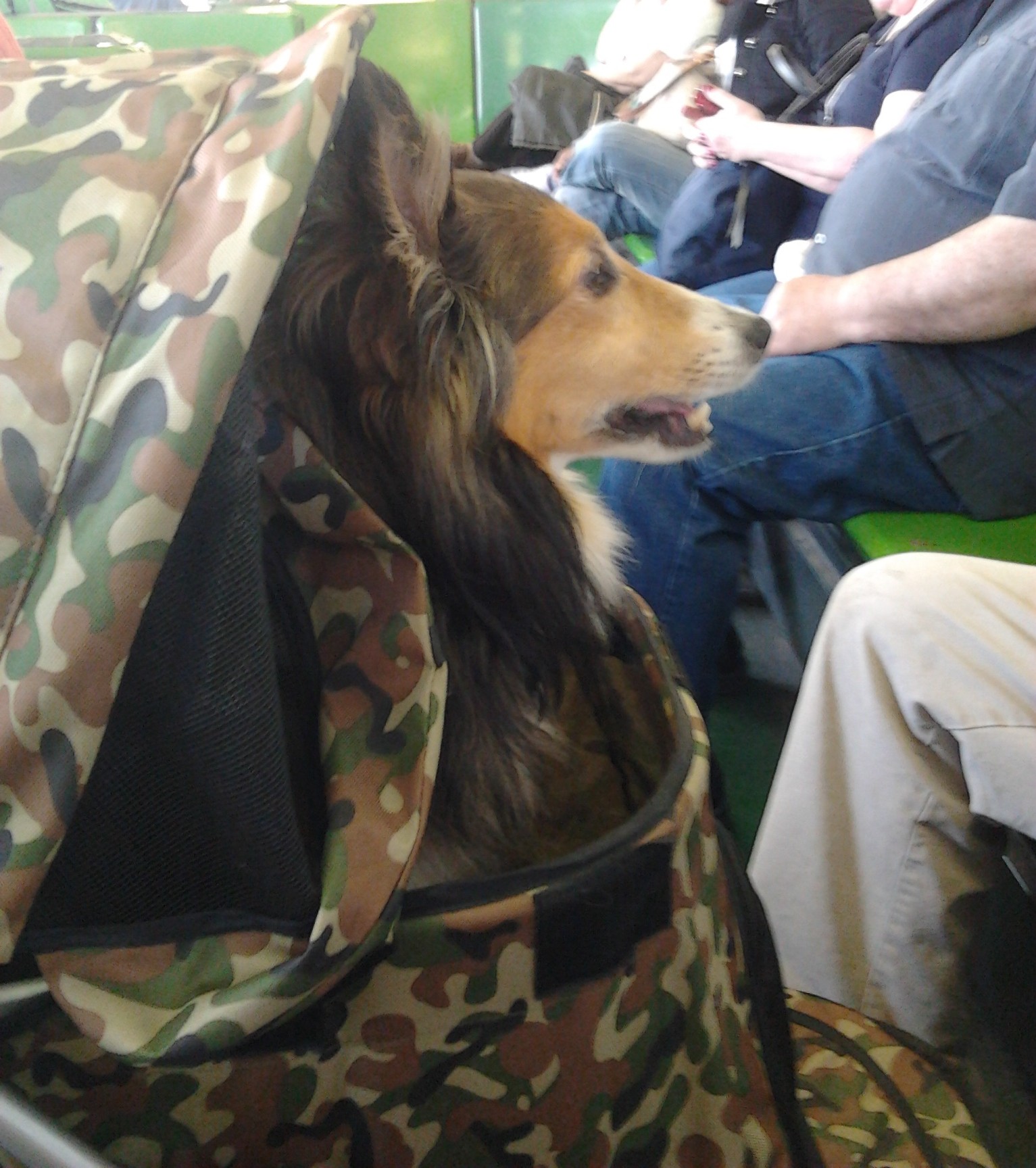 I never would have come up with this one on my own. But as I have found my way through the rivers of people in New York City, I’ve discovered that owners of dogs, particularly small dogs, travel the sidewalks and subways with their pets in purses, totes and, get ready for it, doggie strollers.
I never would have come up with this one on my own. But as I have found my way through the rivers of people in New York City, I’ve discovered that owners of dogs, particularly small dogs, travel the sidewalks and subways with their pets in purses, totes and, get ready for it, doggie strollers.
I don’t necessarily see it every time I get on the subway, but from time to time, there’s Fifi, parked under Mama’s arm, contained in a tote with a mesh window. I would never have envisioned this, even though I am a dog mama and a new immigrant to the really, really, really Big Apple.
I am a reluctant resident at best. Work keeps me here for a few months. My partner C.T. and I have a host who’s opened his Staten Island home to us and our dog, Tuatha. But we want to be able to take Tuatha to Occupy and other outdoor events, and to visit friends, etc.
So as we moved to Staten Island, we took the plunge and ordered a doggie stroller. The experience of shopping online and ordering was simple enough. Not all strollers are created equal; You get what you pay for, etc. I needed a fairly large one for my twenty-nine pound Sheltie, but bigger costs more. After much hunting we found one that fits his frame and has larger, sturdy wheels, a requirement of mine after years of pushing human strollers. An added bonus: Camouflage fabric! I never cease to be amused at camouflage in unexpected or ironic places. My favorite used to be my camouflage cloth menstrual pads, but the fru-fru dog stroller beats that hands down, if only because few people notice what cloth menstrual pad I’m wearing….Sigh.
The stroller was delivered to a friend’s house in Brooklyn. So before we took it home, we used it to carry C.T.’s consensus books to an Occupy event in Central Park. This was when I learned about stroller culture, and the secret tribe of people who know stroller ways.
First, people made way for me, held doors for me and made adoring looks at me, even though the stroller was empty. In the subway, when an escalator was broken someone grabbed the front of the stroller and carefully helped me carry it down the stairs while carefully keeping it level, so as not to wake the sleeping…books and flowchart handouts.
Sitting on the subway or in a restaurant, I would notice a human toddler in a stroller staring at me with a mommy vibe, as if I must know mommy things because I am sitting next to a stroller.
Just as other people with dreadlocks make eye contact with me and give a knowing nod, now so would stroller people. All this while I was pushing books.
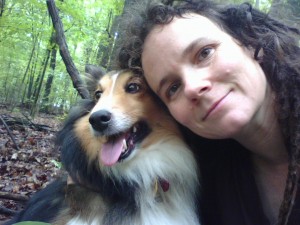 Once at home, just presenting the new conveyance to Tuatha was worth the investment. I wish I had videotaped it. Tuatha was like a kid who’s letter to Santa got answered. He seemed to know what it was for and that it was his, before we even put him inside. He circled it, chirping and nipping at it, then rushing between me and C.T. to nuzzle and kiss. He was sooo thrilled! It was as if he saw this thing with wheels that was his size, and he just knew he’d been given his first car.
Once at home, just presenting the new conveyance to Tuatha was worth the investment. I wish I had videotaped it. Tuatha was like a kid who’s letter to Santa got answered. He seemed to know what it was for and that it was his, before we even put him inside. He circled it, chirping and nipping at it, then rushing between me and C.T. to nuzzle and kiss. He was sooo thrilled! It was as if he saw this thing with wheels that was his size, and he just knew he’d been given his first car.
When we put him inside and velcroed the mesh cover around him, he sat beaming. And he was unphased by the first movement, and the bumps in the driveway. He just looked at us through the mesh window in the top, and checked our location through his side view, and he was good to go, go, go.
Knowing that we wanted to eventually take him on public transportation, we decided to first take him to a park, creating positive associations. Even though he didn’t need to ride in the stroller to the nearest park, he did so, and loved every moment, not even missing all the poles and bushes he would have wanted to mark.
At the park, he got out, played fetch, relaxed with us, and then got a stroller ride home. Perfect! Next, a dry run on the ferry.
The Staten Island Ferry is free, and just a few blocks from our house. So when we need to go to work downtown we are able to walk to the dock, take the ferry and then we’re in Manhattan. Our only transportation cost is the subway. Before, when we were staying far out on Long Island, a trip into the city cost the two of us nearly $100, between the Long Island Railroad, subways and food.
So a ferry ride, our first experiment with Tuatha and public transportation, would only cost us our time. We walked him by leash to the ferry terminal, put him in the stroller and onto the ferry. The only surprise was that Tuatha became unhappy when his stroller was not being pushed. When we stood still in line and when we were in our seats on the ferry, he complained. He wanted us to make his little car go!
On the sidewalk, and in line for the ferry, some people would look inside the stroller to discover that our child was a dog. It’s funny. There are people who will look in strollers and those who just don’t. Tuatha got many ooohs and ahhhs everywhere he went. I’m sure there were people who thought it was terrible, but no one confronted us.
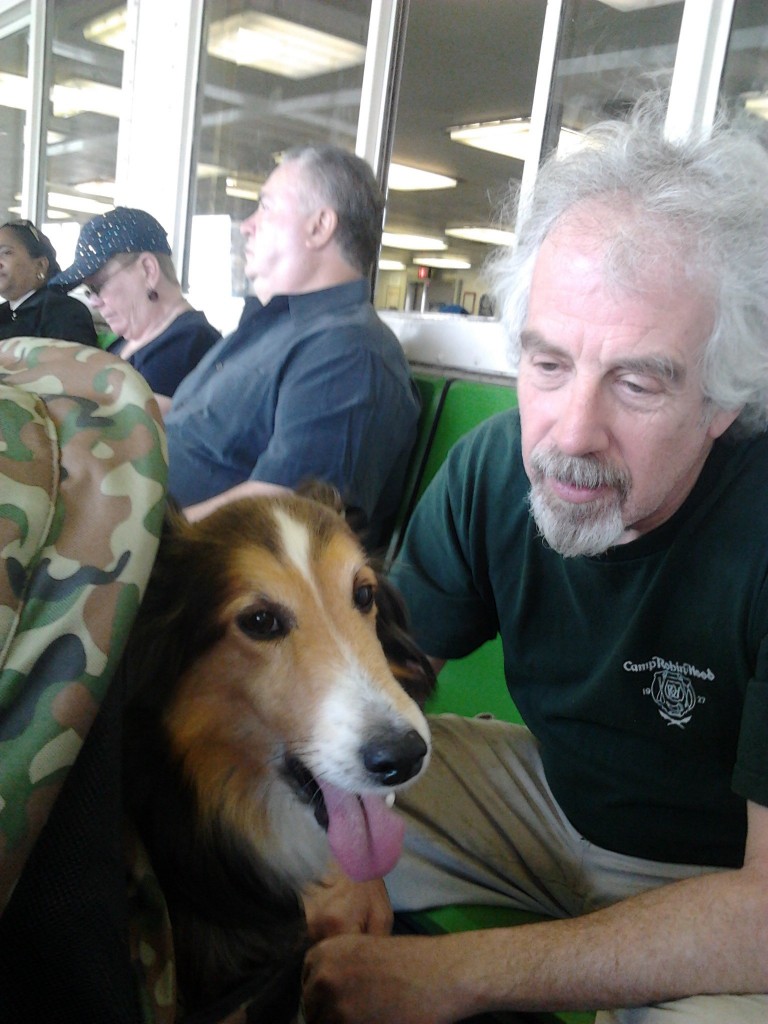 Having ridden the ferry about a dozen times before Tuatha got on, I was worried that the loud foghorn would scare him. Same for the scrape that the ferry makes against the wood pier when it docks. So we made sure to be on the far side of the ferry from those stimuli. Otherwise, the ferry’s motions and engine sounds were gentle enough that Tuatha seemed unphased. Just bored that his car had stopped!
Having ridden the ferry about a dozen times before Tuatha got on, I was worried that the loud foghorn would scare him. Same for the scrape that the ferry makes against the wood pier when it docks. So we made sure to be on the far side of the ferry from those stimuli. Otherwise, the ferry’s motions and engine sounds were gentle enough that Tuatha seemed unphased. Just bored that his car had stopped!
On the Manhattan side, we wheeled him off for a nice relaxing picnic in Battery Park next to the ferry terminal. Since it’s New York, there was no finding a bench for just ourselves, so Tuatha worked on bribing the people on either side of us into sharing their bread. He has a bread addiction. And this was a park where his drug of choice could be had. He didn’t score, but he tried.
Next we’ll have to venture onto the subway with him, during some off peak time. The subway is much louder but, given how well he’s taken to stroller travel so far, he may avoid panic by feeling secure in his enclosure. I won’t push the issue if he doesn’t like it, of course.
But I already consider the stroller experiment successful, not because it provides me with flexibility, but because Tuatha gets such a kick out of it! I strolled him to the fruit stand the other day and he could roll through the open air market with me, complaining when I stopped to examine produce. I put my selections on top of the stroller and put my purchases in the storage bin underneath for the stroll home.
One challenge is that our host’s house is at the top of a long, steep hill that empties into the bay. So every trip everywhere starts with a long walk down and ends with a long walk up. But if Tuatha and I make more trips to the produce stand for fewer things, I get more exercise in the long run, and let no one dispute that I need exercise.
Already I have date set for tomorrow. Tuatha and I will stroll with a friend from Ganas Community. C.T. and I are lucky to be just a few blocks away from an Intentional Community where we know many people. Some of them are, I believe, stroller people…
Are Dragons Nocturnal?
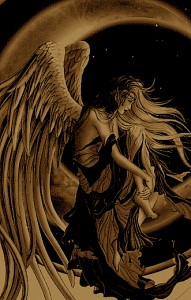 Are there wild monkeys in Maryland? Do raccoons pitch baseballs? Are dragons nocturnal? I’ve been trying to solve a mystery for the past few nights.
Are there wild monkeys in Maryland? Do raccoons pitch baseballs? Are dragons nocturnal? I’ve been trying to solve a mystery for the past few nights.
I’ve been enjoying the clean forest air, sleeping in a tent behind my cabin on Heathcote Community’s 110 acre wooded land trust. I’m tenting behind my house because, again this year, large black rat snakes have found access into my living space. This time, the story begins with the end of the world:
Remember Harold Camping’s predictions that the world would come to an end last May 21, 2011, at 6pm? Well, around 5pm, I strutted upstairs to where my partner C.T. was napping, to ask him how he wanted to spend the last hour of life. Since we’d just made love about an hour before, I didn’t want to assume he’d choose that. So we sat listing our options when something came crashing down in the kitchen.
“I didn’t like the sound of that,” I said.
“Is the end starting early?” C.T. wondered.
I tip toed about half way down the stairs and hugged the railing as I got confirmation of my fear: There was a four and a half foot black rat snake making its way from a shelf to the top of my refrigerator.
For those of you who don’t follow my website regularly, I don’t own any pet snakes.
“This means I’m not sleeping in this house tonight,” I told C.T. He kept an eye on our intruder’s movements while I gathered up my tent and assorted supplies. We ended up spending a few hours scooping out a level platform for the tent, since the woods is on a slope here. Last year the most level spot we could find still had us inching downhill all night long in our sleep. Now, level and happy, we sleep in a spacious tent while we seek and patch access holes. We have an extension cord and power strip going out to the tent so we have a lovely night stand with a lamp. We can recharge our cellphones and use them for alarm clocks. And we power a fan when needed.
 But even though I’m enjoying the hell out of my tent, someone in the woods is taking exception to my new construction. About a week ago, the assault came from above. With lights out, several times over one night, it sounded almost like someone was dropping a whole bucket of water from above. But it wasn’t raining. The next morning we discovered our rain fly was decorated with some kind of non-mammal excrement. (For this post, I asked C.T. how you spell excrement. He said, “m-e-s-s-y.”) Looking above the area we found very a cool fork of a branch, with an s-shaped twist in it. If I were a bird or a bunch of mating snakes, that would be a comfy roost.
But even though I’m enjoying the hell out of my tent, someone in the woods is taking exception to my new construction. About a week ago, the assault came from above. With lights out, several times over one night, it sounded almost like someone was dropping a whole bucket of water from above. But it wasn’t raining. The next morning we discovered our rain fly was decorated with some kind of non-mammal excrement. (For this post, I asked C.T. how you spell excrement. He said, “m-e-s-s-y.”) Looking above the area we found very a cool fork of a branch, with an s-shaped twist in it. If I were a bird or a bunch of mating snakes, that would be a comfy roost.
But the sheer volume of the excrement and the multiple offenses…snakes? Owl?
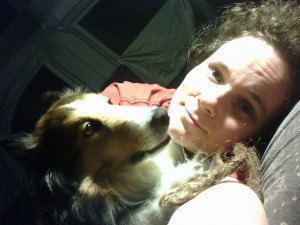 Every night when we enter the tent to go to bed, our dog Tuatha goes with. But he only lasts a few minutes before nuts from the trees above start falling and hitting the tent. Tuatha goes into panic mode and insists we evacuate. And when we show no interest, he scratches on the door of the tent, every dog for himself.
Every night when we enter the tent to go to bed, our dog Tuatha goes with. But he only lasts a few minutes before nuts from the trees above start falling and hitting the tent. Tuatha goes into panic mode and insists we evacuate. And when we show no interest, he scratches on the door of the tent, every dog for himself.
At this point, C.T. calls him scaredy-cat, to which Tuatha has no objection, as long as he can get back into the cabin to spend the night hiding under large heavy furniture. Tuatha apparently prefers the threat of snakes in the house to bombs from above.
For the past few nights, the bombings have been particularly frequent. As a matter of fact, C.T. and I could swear that the nuts are being thrown, not just dropping. They hit so hard. And, here’s the kicker, they’re coming in sideways!
“Maybe the squirrels are annoyed by our lamp and want us to turn out the light,” C.T. guessed.
 “Squirrels are going to stay in their homes at night. They’re not going to risk getting eaten just to throw nuts at us,” I countered. “Although flying squirrels are nocturnal…” We did have a flying squirrel slam into the tent side a couple of nights before.
“Squirrels are going to stay in their homes at night. They’re not going to risk getting eaten just to throw nuts at us,” I countered. “Although flying squirrels are nocturnal…” We did have a flying squirrel slam into the tent side a couple of nights before.
“Maybe they’re frightened or annoyed or jealous of all the sounds we’re making,” C.T. continued, referring to our tendency to be very vocal during sex.
I tried to imagine a squirrel or raccoon with inadequacy issues. “Frightened, maybe,” I answered. “I guess we’re the noisy neighbors of the woods.”
Still we couldn’t place the source or catch anyone in the act. I started pondering the period of time about three years ago when we had other odd occurrences at Heathcote.
I recalled walking in the woods with the Open Classroom kids when we came upon a mass of some almost alien looking substance on the ground, a few feet from the entrance to a small cave. The stuff was greenish-yellowish, slightly more firm than gelatin and in a pile on the leaf litter. There was about a gallon of it.
Was it some kind of fungus or giant frog egg cluster? We couldn’t find any attributes that identified the mass. We were left with only one conclusion, given it’s proximity to the cave: Dragon snot.
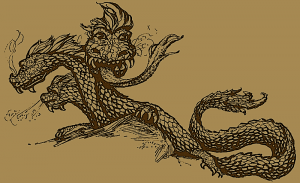 This was the beginning of several months of sightings, almost-sightings, alleged sightings and many clues discovered and debated. At first most of the reports came from kids. But eventually adults also came forward with stories of dragon sightings in the Heathcote forest.
This was the beginning of several months of sightings, almost-sightings, alleged sightings and many clues discovered and debated. At first most of the reports came from kids. But eventually adults also came forward with stories of dragon sightings in the Heathcote forest.
I myself was startled by the dragon up at 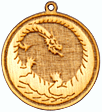 Bill Anacker’s house once. I ran a twisted course through the swings in Bill’s yard, barely making it to the front door. The dragon was on my heels so near, that I had to dive trough the oversized doggie door. I didn’t even have time to turn a door knob!
Bill Anacker’s house once. I ran a twisted course through the swings in Bill’s yard, barely making it to the front door. The dragon was on my heels so near, that I had to dive trough the oversized doggie door. I didn’t even have time to turn a door knob!
Over time, sightings became less frequent. I haven’t heard of any lately. But now, with this anomalous event of nuts, dirt clumps and feces being thrown at our tent, I wonder.
There’s nothing like a tent, made of polyfiber only a couple of millimeters thick, staked under fifty-foot trees in a hundred acre wood, to give one pause about one’s place in nature and the food chain. Turn out the light, listen to the quiet of the night, then have it disturbed by tiny bombs, bombs that have been falling to Earth every year for millenia.
For millenia, animals like me have been discovering dragons.
—WT
Please join our Hippie Chick Diaries fan page on Facebook!
Bunny & Box Turtle Crossing
 As I finished making signs to post around Heathcote, advertising my porch sale, my dog Tuatha took advantage of my distraction to slip away for a little “me time” adventure.
As I finished making signs to post around Heathcote, advertising my porch sale, my dog Tuatha took advantage of my distraction to slip away for a little “me time” adventure.
Tuatha knows this distresses me. I want to keep him safe, away from car wheels and copperheads. But I have to admit that, on a hot June day like today, I’d love to slip away and play in the stream, too.
So I loaded my signs and myself into the car and went looking for him. When he runs away, I always have to talk to myself to remain calm and methodical.  Once when I let my anger express itself in driving down the road much too fast, I ran over a groundhog. I felt horrible. And, of course, I realized that it could have been my own lost dog that I killed in an out-of-control moment.
Once when I let my anger express itself in driving down the road much too fast, I ran over a groundhog. I felt horrible. And, of course, I realized that it could have been my own lost dog that I killed in an out-of-control moment.
And today I remembered that awful moment as I talked myself into calm, remembered that I’ve always found him quickly in the past, that he’s much more woods-savvy than I give him credit for, and that I can help him best by breathing and staying connected to my surroundings.
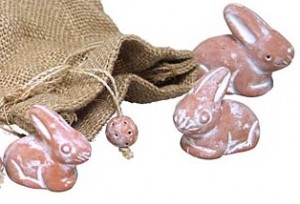 The Universe likes to reinforce these messages, apparently. As I drove around looking for him, driving at a reasonable speed, a rabbit in the road had one of those squirrel moments and zig zagged under my car. But I was in control and managed to not injure it. Later, on a dirt road, a box turtle was well camouflaged as it walked in the rut. If I weren’t paying attention, I would have flattened it. Instead I moved it.
The Universe likes to reinforce these messages, apparently. As I drove around looking for him, driving at a reasonable speed, a rabbit in the road had one of those squirrel moments and zig zagged under my car. But I was in control and managed to not injure it. Later, on a dirt road, a box turtle was well camouflaged as it walked in the rut. If I weren’t paying attention, I would have flattened it. Instead I moved it.
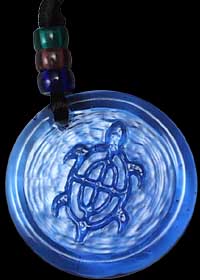 Hares and tortoises. I get it. Even The Universe speaks in cliches .
Hares and tortoises. I get it. Even The Universe speaks in cliches .
Of course, my dog was safe in the bowl of Heathcote the whole time. and I caught up with him at our usual rendezvous point, Bill Anacker’s house. He was dripping wet from cooling off in the stream. I couldn’t be mad at him. Okay, I was still a little, but that’s my stuff…
This is the second time in a week Tuatha has snuck off. I am slow to get the message, but I wonder if there’s a way I can help him cool off while staying safe at home. He loves to play in the hose, but if I could find a little yard sale kiddie pool, he could self select. How about that, Tuatha?
Please join our Hippie Chick Diaries fan page on Facebook!
